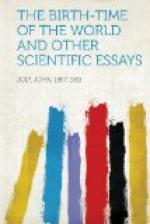ment of the amoeba in resistance to drought. In most cases of hibernation the time-energy function seems maintained at a loss of potential by the organism, a diminished vital consumption of energy being carried on at the expense of the stored energy of the tissues. So, too, even among the largest organisms there will be a diminution of activity periodically inspired by climatological conditions. Thus, wholly or in part, the activity of organisms is recurrently affected by the great energy—tides set up by the Earth’s orbital motion.
{Fig. 6}
Similarly in the phenomenon of sleep the organism responds to the Earth’s axial periodicity, for in the interval of night a period of impoverishment has to be endured. Thus the diurnal waves of energy also meet a response in the organism. These tides and waves of activity would appear as larger and smaller ripples
95
on the life-curve of the organism. But in some, in which life and death are encompassed in a day, this would not be so; and for the annual among plants, the seed rest divides the waves with lines of no activity (Fig. 6).
Thus, finally, we regard the organism as a dynamic phenomenon passing through periodic variations of intensity. The material systems concerned in the transfer of the energy rise, flourish, and fall in endless succession, like cities of ancient dynasties. At points of similar phase upon the waves the rate of consumption of energy is approximately the same; the functions, too, which demand and expend the energy are of similar nature.
That the rhythm of these events is ultimately based on harmony in the configuration and motion of the molecules within the germ seems an unavoidable conclusion. In the life of the individual rhythmic dynamic phenomena reappear which in some cases have no longer a parallel in the external world, or under conditions when the individual is no longer influenced by these external conditions.,, In many cases the periodic phenomena ultimately die out under new influences, like the oscillations of a body in a viscous medium; in others when they seem to be more deeply rooted in physiological conditions they persist.
The “length of life is dependent upon the number
[1] The Descent of Man.
96
of generations of somatic cells which can succeed one another in the course of a single life, and furthermore the number as well as the duration of each single cell-generation is predestined in the germ itself."[1]
Only in the vague conception of a harmonising or formative structural influence derived from the germ, perishing in each cell from internal causes, but handed from cell to cell till the formative influence itself degrades into molecular discords, does it seem possible to form any physical representation of the successive events of life. The degradation of the molecular formative influence might be supposed involved in its




